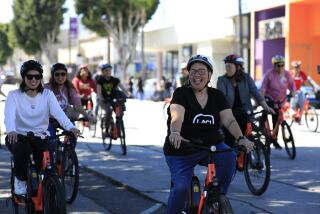In the front seat at the ride-sharing revolution

I was introduced to the sharing economy a few years ago, when my youngest daughter was studying in Denmark and trying to travel Europe on the cheap.
“Couch surfing” she called her lodging technique. You book a spot online on the couch of a stranger in a foreign country; stay the night, then move on.
I thought it was lunacy and dangerously na¿¿ve. She thought it was a great way to meet people and learn about the world.
She and her friends survived the year unscathed and with great stories. And I began to trust what’s being called the “peer-to-peer economy.”
That’s how I wound up in a stranger’s car at midnight in Palo Alto, trying to make it to the Caltrain station before the last train to San Francisco departed.
I’d missed the Stanford jitney and couldn’t get a cab, so I downloaded the Uber app on my cellphone, loaded my credit card info and tapped in my destination. Seven minutes later, I was sitting next to Bereket, who’d been playing cards with friends in a campus dorm when his phone pinged with my request.
The trip was a bit of an adventure. Bereket was from out of town and didn’t know his way around. GPS service was spotty, so we made a few wrong turns. But he was pleasant, his car was clean, and I got to the station on time — and for half of what it would have cost if I had taken a cab.
Consider me a convert. I was once suspicious of riding with a stranger. Now, like tens of thousands of other people across the country, I use Lyft and Uber to fill gaps in public transit or to bail me out of jams.
It’s a transportation revolution, and there are bound to be winners and losers.
Taxi drivers are up in arms, their livelihoods at stake. I understand that; I felt the same way years ago when news apps began nudging newspapers toward obsolescence. We learned from the competition and adapted. Cab companies will too.
It’s a fact of life. All around us, old business models are being replaced by technology-driven versions that better fit the realities of busy, fragmented lives.
And the biggest threat to consumers in the car-sharing process is not some random psycho driver, but the muscle of the private cab companies that want them to disappear and the reflexive rush toward regulation by fear-mongering politicians.
::
The ride-sharing trend began in the Bay Area a few years ago. Now Uber operates in every continent except Antarctica, Lyft is making it easier to get around in neighborhoods that cabs won’t go near, and Sidecar has figured out how to let riders know exactly how much the trip will cost before the ride begins.
California created the nation’s first regulations for the upstart firms last fall. Drivers have to undergo background checks, and companies have to provide $1 million of liability insurance. Debate is still underway in Sacramento about whether that’s enough.
In Los Angeles, City Council members — some elected with the help of taxi industry contributions — are trying to saddle the ride-sharing firms with tighter rules and stifling insurance requirements. Mayor Eric Garcetti, to his credit, sees the risk in that. He considers ride-sharing companies a flexible, cost-effective alternative to taxis.
Cab companies could learn from Uber and Lyft. Here’s what traditional taxi customers don’t like: long waits, cash only fares (your credit card reader just happens to be broken — again) and surly drivers who turn their noses up at short trips or rides through dicey areas.
What we do like is the convenience and transparency of the ride-sharing process. I was hooked the night I bought too many groceries on a trip to the market in San Francisco. I’d walked to the store but couldn’t haul the heavy bags back to my daughter’s apartment.
I ordered a Lyft from the app on my phone, received the driver’s photo, a description of his car and an estimate of when he would arrive. Twelve minutes later, for about the cost of a venti latte, Samuel was helping me unload my bags from his late-model Toyota.
There are bound to be a few rogue drivers that give the companies a bad name. An Uber driver in Washington, D.C., was charged last week with sexual assault for allegedly fondling a female passenger who had passed out in his car. But he was quickly tracked down and arrested because the Uber receipt includes the name of the driver and model of the car.
The companies don’t need Big Brother. They understand the value of a good reputation and know how to quickly adapt. Lyft is toning down its touchy-feely vibe and downsizing its trademark pink mustache in some markets; they realize we don’t need a party, just an efficient ride. And Uber is reconsidering its “surge” pricing concept that pegged prices to demand.
What used to be considered underground, rag-tag, even seedy is becoming mainstream. Young people are more trusting, less fear-driven than my generation tends to be.
People who’ve grown accustomed to hordes of ersatz friends on Facebook and Instagram are more comfortable taking rides from strangers on Lyft, renting rooms from strangers on Airbnb, letting strangers rent their cars through FlightCar while they are out of town.
You can grumble about the risks of the new sharing economy, but when American Express offers double rewards points for charging an Uber ride, how radical can it be?
Twitter: @SandyBanksLAT
More to Read
Start your day right
Sign up for Essential California for news, features and recommendations from the L.A. Times and beyond in your inbox six days a week.
You may occasionally receive promotional content from the Los Angeles Times.







